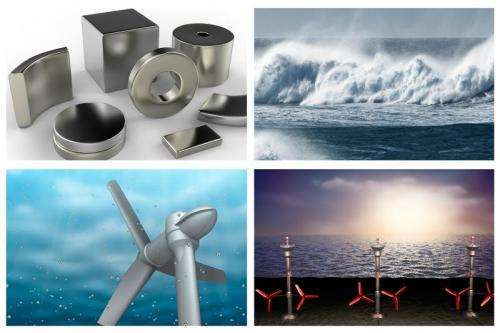New magnetic materials for extracting energy from tides

The objective of the MAGNETIDE project is to develop a new type of generator that transforms the mechanical energy produced by the movement of the tides into electric energy. Researchers have modified the generator's design so that components manufactured using PIM, Powder Injection Moulding, could be installed. This would reduce the cost of these systems as well as increasing their efficiency by up to 30 percent , according to the scientists' calculations.
"These generators use magnetic components that we are producing using PIM technology, which turns out to be more versatile when it comes to modifying the compositions and makes it possible to get the parts for a lower price," explains the researcher who is coordinating UC3M's participation in this project, the tenured professor José Manuel Torralba, of the university's Powder Technology Research Group (Grupo de Tecnología de Polvos -GTP).
Powder injection moulding is proving to be a real alternative in the manufacture of complex parts with a high rate of production. This is confirmed by a paper that these researchers recently published in the "International Journal of Microstructure and Materials Properties", in which they describe the different stages in the manufacturing process and the solutions that it has provided with respect to the Powder Technology Group.
Powder Injection Moulding is an advanced powder metallurgy technology that combines the advantages of plastic injection moulding and powder technology. It is similar to making bread in an oven but, rather than flour, it uses alloys of metallic powders that "bake" in moulds and produce milimetrically exact parts. In this case, the scientists are studying the best combination of metallic powders with a magnetic character (iron, silicon, cobalt, nickel…) in order to later inject them into a polymer plastic mould that will allow them to create complex parts that are difficult and expensive to produce mechanically. "The great advantage of this technology is that once you design the material, by modifying the mould, it is easy to manufacture millions of pieces that are exactly the same, in a manner that is simple, fast and quite inexpensive", explains Torralba.
The project will be finished next year, which is when the scientists expect to have the first prototypes of generators made with this technology ready. These devices, which could also be used for wind and other alternative energy source generators, could be put into use in areas where there are strong tidal currents, such as the west coast of Canada, Southeast Asia and Australia, the Bosporus and, in the case of Spain, the Strait of Gibraltar.
More information: "Powder Injection Moulding: Processing of small parts of complex shape." Torralba, J.M.; Hidalgo, J.; Jimenez-Morales, A. International Journal of Microstructure and Materials Properties, Volume: 8. Number: 1-2. Pages: 87-96. Publication date: 2013
Provided by Universidad Carlos III de Madrid




















